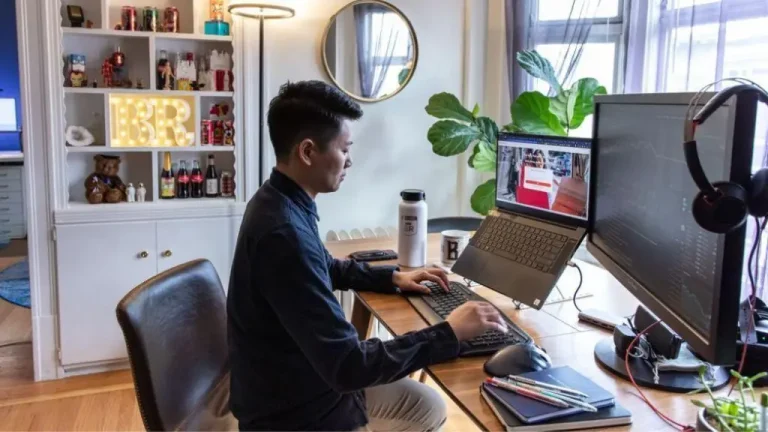As the remote work trend continues to rise, creating an efficient and comfortable home office workspace has become essential. A well-designed home office not only boosts productivity but also enhances overall well-being. Here are some practical solutions to optimize your home office setup.
Creating the Ideal Home Office Workspace: Solutions for Productivity and Comfort requires a blend of ergonomic design, efficient organization, and personalized aesthetics to maximize productivity and comfort. A well-designed home office should start with ergonomic furniture, such as an adjustable chair and desk, to support proper posture and reduce physical strain during long working hours. Adequate lighting, including natural light and task lighting, helps reduce eye strain and boosts alertness. Organizing the workspace with ample storage solutions and decluttering techniques can enhance focus and efficiency. Personal touches, such as plants and inspiring decor, can create a pleasant and motivating environment. Additionally, incorporating technology solutions, like noise-canceling headphones and high-speed internet, ensures a seamless workflow. By addressing these elements, one can create a home office that not only fosters productivity but also ensures comfort and well-being, making it the ideal workspace.
Choosing the Right Location
The first step in setting up a home office is selecting an appropriate location. Ideally, this should be a quiet area with minimal distractions. If possible, choose a room with a door to separate your work environment from the rest of your home. If space is limited, consider using a corner of a room that receives plenty of natural light, which can significantly improve your mood and energy levels.
Ergonomic Furniture
Investing in ergonomic furniture is crucial for maintaining comfort and preventing health issues. Here are key pieces to consider:
- Ergonomic Chair: A good ergonomic chair supports your lower back and promotes good posture. Look for chairs with adjustable height, lumbar support, and a comfortable seat cushion.
- Adjustable Desk: An adjustable desk allows you to alternate between sitting and standing positions, reducing the risk of sitting-related health problems. Standing desks or sit-stand converters are excellent options.
- Monitor Stand: A monitor stand can help position your screen at eye level, reducing neck and eye strain. Ensure your monitor is directly in front of you at about an arm’s length away.
Optimizing Lighting
Proper lighting is essential for a productive home office. Natural light is best, so position your desk near a window if possible. To reduce glare and eye strain, use a combination of ambient, task, and accent lighting:
- Ambient Lighting: This is the general lighting of the room, typically provided by ceiling lights. Ensure your ambient lighting is bright enough to illuminate the entire space without causing glare.
- Task Lighting: Task lighting, such as desk lamps, provides focused light for specific tasks like reading or writing. Adjustable lamps with LED bulbs are energy-efficient and offer customizable brightness levels.
- Accent Lighting: Accent lighting adds a decorative touch and can highlight specific areas or objects in your office. Use it sparingly to create a balanced and inviting atmosphere.
Organizing Your Space
A clutter-free workspace promotes focus and efficiency. Here are some tips for keeping your home office organized:
- Storage Solutions: Use shelves, cabinets, and storage bins to keep your office supplies, documents, and personal items neatly organized. Labeling storage containers can help you quickly find what you need.
- Cable Management: Manage cables and cords using cable organizers, clips, and sleeves. Keeping cords tidy not only improves the aesthetics of your workspace but also reduces tripping hazards.
- Minimalist Approach: Adopt a minimalist approach by only keeping essential items on your desk. This reduces distractions and creates a cleaner, more focused work environment.
Incorporating Technology
Technology plays a vital role in a functional home office. Ensure you have the necessary equipment and software to perform your tasks efficiently:
- High-Speed Internet: Reliable internet connectivity is crucial for remote work. Invest in a high-speed plan and consider a Wi-Fi extender if your home office is far from the router.
- Quality Computer and Accessories: A fast and reliable computer, along with peripherals like a wireless keyboard, mouse, and headset, can enhance your work efficiency. Dual monitors can also boost productivity by providing more screen space for multitasking.
- Video Conferencing Tools: Equip your office with a good webcam and microphone for clear video and audio during virtual meetings. Ensure your video conferencing software is up-to-date and functioning properly.
Personalizing Your Space
Personalizing your home office can make it more enjoyable and motivating. Consider adding elements that reflect your personality and inspire you:
- Decor: Incorporate artwork, plants, and personal items that make you feel comfortable and happy. Plants can improve air quality and add a touch of nature to your space.
- Color Scheme: Choose a color scheme that promotes calmness and focus. Soft, neutral colors are generally best for a productive environment, while splashes of vibrant colors can add energy and creativity.
- Comfort Items: Include comfort items like a cozy throw blanket, a cushioned chair pad, or a small fan or heater to maintain a comfortable temperature.
Maintaining Work-Life Balance
One of the challenges of working from home is maintaining a clear boundary between work and personal life. Here are some strategies to help:
- Set a Schedule: Establish a consistent work schedule and stick to it. Clearly define your start and end times to create a routine.
- Take Breaks: Regular breaks are essential for maintaining productivity and well-being. Use breaks to stretch, walk, or engage in a non-work-related activity.
- Separate Work and Personal Life: At the end of your workday, shut down your computer and leave your home office. This physical separation can help signal the end of the workday and the start of personal time.
Conclusion
Creating an ideal home office workspace involves thoughtful planning and investment in ergonomic furniture, proper lighting, organization, technology, and personalization. By setting up a well-designed home office, you can enhance your productivity, comfort, and overall work experience, making remote work a positive and sustainable part of your professional life.





